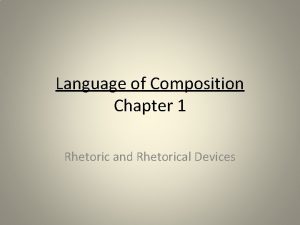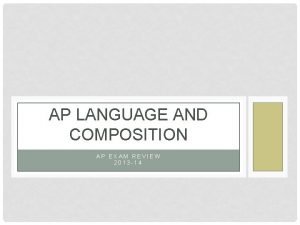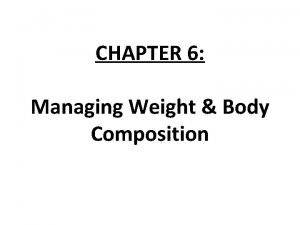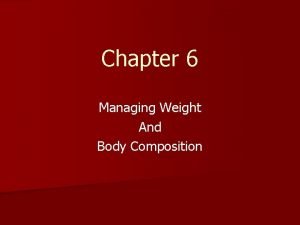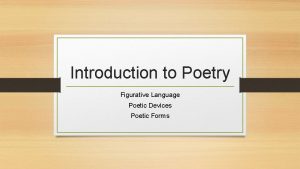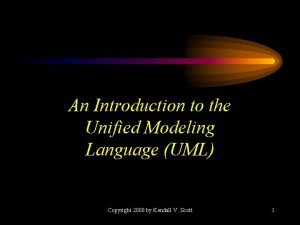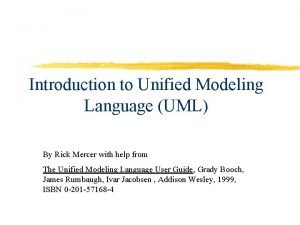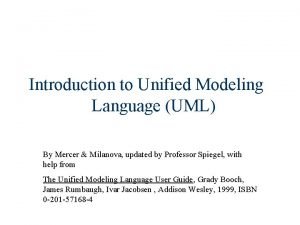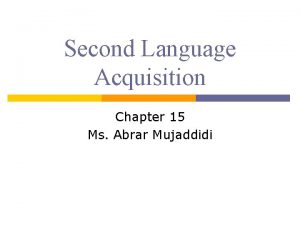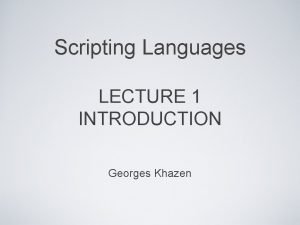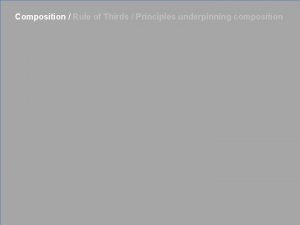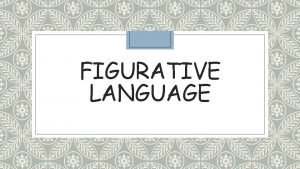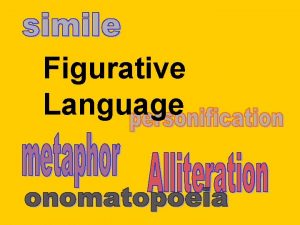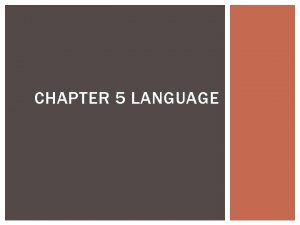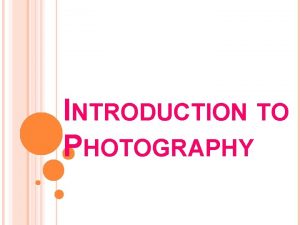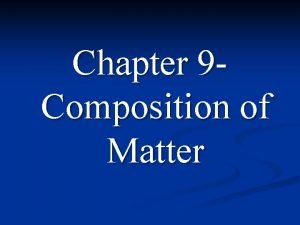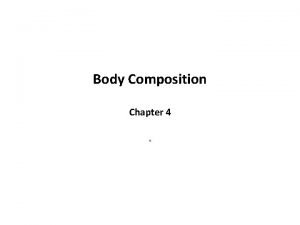THE LANGUAGE OF COMPOSITION Chapter 1 An Introduction




































































- Slides: 68

THE LANGUAGE OF COMPOSITION Chapter 1 An Introduction to Rhetoric

Key Elements of Rhetoric Rhetor: The speaker who uses elements of rhetoric effectively in oral or written text. Rhetoric: The art of analyzing all the choices involving language that a writer, speaker, reader, or listener might make a situation so that the text becomes meaningful, purposeful and effective; the specific features of texts, written or spoken, that cause them to be meaningful, purposeful, and effective for readers or listeners in a situation.

Key Elements of Rhetorical Choices: The particular choices a writer or speaker makes to achieve meaning, purpose, or effect. Rhetorical situation: the convergence in a situation of exigency (the need to write), audience and purpose. Rhetorical Triangle: more on this later.

Key Elements of Rhetoric Read aloud the speech by Lou Gehrig that he gave at an Appreciation Day held in his honor on July 4, 1939. Listen once, then listen again and then we will look at the speech from a rhetorical perspective.

Why is this an effective speech? Rhetoric is always situational: it has a context – the occasion or the time and place it was written or spoken – and a purpose or goal that the speaker or writer wants to achieve. Rhetoric Man is effective because he has an occasion and a goal or purpose. Think about it, without them, what use is he? He just looks like a rocker from the 80 s.

Context and Purpose When we read any text, we ask about the context in which it was written. Then we consider the purpose. Is the speaker trying to win agreement? persuade us to action? evoke sympathy? make us laugh? inform, provoke, celebrate, repudiate?

Context Sometimes context arises from current events or cultural bias. What is bias? Ex. Someone writes about freedom of speech in a community that has experienced hate graffiti must take that context into account and adjust the purpose of the piece so as not to offend the audience. Think of some examples where you would consider the context of what you have to say.

Why is Lou effective? Main idea = thesis, claim or assertion His main idea is a clear, focused statement. Gehrig knows his subject—baseball As a speaker he has credibility and the sympathy of the crowd. Why is _______ effective is a question we will ask and answer ad infinitum, ad nauseum.

The Rhetorical Triangle Here it is, the Aristotelian rhetorical triangle Speaker Audience Subject

Determines the Argument Speaker Audience Subject

First you choose a subject and then what do you do? You tell me! What are some arguments you might present today? Dress code? Eating in classrooms? Cell phones? Pick one

First you choose a subject Then you evaluate what you already know about it What others have said about it And what kind of evidence or proof will sufficiently develop your position.

Speaker Aristotle called the person that a writer took on as a speaker as a persona. A persona is the character the speaker creates when he or she writes or speaks This depends on the context, purpose, subject and audience. Are you speaking as a poet, comedian, scholar, expert, critic, citizen, etc.

Audience Before you speak, you must consider your audience. What do they know about your topic? What do they feel about your topic? How will you communicate with them to listen to you?

After analyzing the relationship of speaker to subject, audience to speaker, and audience to the subject, a writer is ready to make some choices. Speaker Audience Subject

Ethos, Logos, and Pathos Learn the terms then forget them…. Ethos- the credibility of the speaker Logos-the reasoning or logic in the speaker’s argument. Pathos- Emotion of the speech (not necessarily the speaker’s, but more explanation in a minute. )

Now, relearn and use these terms instead Ethos = Ethical appeal Logos = Logical appeal Pathos = Emotional appeal

Ethos Ethos = Ethics=Ethical appeal If someone is ethical they have credibility. Ethical appeal has to do with the speaker. Is the speaker ethically credible? This does not mean whether or not the speaker is a good person. It means the speaker appeals to the audience as a credible source.

Example If a speaker wants to talk to you about adolescent alcoholism, what kind of speaker would have the most ethical appeal? If a teacher wants to teach you about algebra, what kind of teacher would have the most ethical appeal?

? So what is the ethical appeal of Lou Gehrig? In some cases, a speaker’s reputation immediately establishes ethos. For example, the speaker may be a scholar in Russian history and economics as well as a secretary of state. In most cases, the speaker establishes ethos by making a good impression.

How do you make a good impression? That impression may result from a tone of reason and goodwill Or from the type and thoroughness of information presented. The speaker’s ethos—expertise and knowledge, experience, training, sincerity, or a combination of these—gives the audience a reason for listening.

Logos Logos = Logical Appealing to logos means having a clear main idea or thesis, with specific details, examples, facts, statistical data, or expert testimony as support. OK trekkies, you get this one. Spock would never say anything that was not full of Logical Appeal. He always backed up what he said with facts or logic in reasoning.

Example Gehrig’s speech is full of logic. Thesis: “he is the luckiest man on the face of the earth” and he supports it with two points. Can you find the two points?

Here are his two supports 1. his seventeen years of playing baseball and 2. his belief that he has “never received anything but kindness and encouragement from [his] fans. ” Specifically, he has worked with good people on the field, he’s been part of a sterling team, and he has the “blessing” of a supportive family. Yet, he got a “bad break. ”

? What assumption or underlying belief, links these seemingly contrasting ideas? First, what are the ideas that are in contrast? Second, what does he and his audience assume?

Answer He is lucky even though he’s had a bad break (contrast) He assumes, as his audience does, that bad breaks are a natural part of life. (assumption)

Another approach Acknowledge a counterargument. to anticipate objections or opposing views. You agree (concede) that an opposing argument may be true, but then you deny (refute) the validity of all or part of the argument. THIS STRENGTHENS YOUR ARGUMENT!!! It shows you really thought about it.

Pathos Pathos = emotional appeal Does the writing appeal or create emotions in the reader? Too much emotional appeal is rarely effective, but if a skilled writer tells an anecdote or uses certain figurative language, he or she can create an emotional appeal to the audience.

? Does Gehrig use emotional appeal (pathos)? How does he do it?

1. He speaks for himself, someone already well loved. He uses “I” often. 2. he uses words with strong positive connotations: greatest, wonderful, honored, grand, blessing. He uses one image—tower of strength–an image his audience would understand probably use themselves.

Too much emotion An argument that appeals only to the emotions is by definition weak—it’s generally considered propaganda.

Visual elements A striking photograph may strengthen an argument. Advertisers certainly make the most of photos and other visual images to persuade audiences. So…. what do you do if your audience you are writing for can’t see a photograph?

Practice Read an argument that appeared in a newspaper and analyze the elements we’ve just discussed. The article you will read appeared in the Washington Post on Mother’s Day in 2006. Jody Heyman takes an interesting approach: she organizes her main argument around a counter argument.

Identify her ethical appeal Our government (she is doing this for us. ) “collected data—for Harvard University’s Project on Global Working Families and at Mc. Gill University. ” Her biographical note states that Heyman was the director or founder of each project She indicates she has written a book on the topic

Where was this published? Why is this significant? Would she be credible with an audience in a more conservative outlook, like Texas or Alabama? Why or why not?

Identify her logical appeal She uses facts and figures, presumably from the data she collected. She uses contrast with the facts in other countries. She frames her viewpoint not as a women’s rights issue but as an economic one. She appeals to reason by analyzing cause and effect. She deals with the central objections and calls the counterarguments to her “myths. ” (Note the connotation of the word myth. )

Pathos Where is it? What about her occasion? What is significant about it for her article?

Einstein Assignment Read his letter to Phyllis Wright who asked him if scientists pray, and if so, what do they pray for. How rhetorically effective do you find Einstein’s response? Explain your answer in terms of subject, speaker, audience; context and purpose; and appeals to logos, ethos, and pathos.

Visual Rhetoric is often satirical or sarcastic and critical.

Although political cartoons are often satiric, they may also comment without sarcasm or criticism. What is the subject? Who is the audience? What is his purpose? Who is the speaker? What is the context?

What establishes his ethical appeal? What establishes his emotional appeal? What is the logic in the cartoon?

Assignment Analyze a political cartoon in terms of the rhetorical triangle and its appeals to logos, pathos, and ethos. As part of your analysis of audience note if possible where the cartoon first appeared and describe that source’s political leanings. Finally, examine the interaction of written text and visual images. One or two paragraphs should be sufficient. This is just an analysis not an argument.

An Example of Rhetoric from Literature Book 24 of Homer’s epic The Iliad The story of the Trojan War, the Greek warrior Achilles has defeated the Trojan prince Hector. Achilles not only refuses to return his rival’s body to troy, but he also dishonored it by lashing it to a chariot and pulling it through the dirt.

Priam’s speech Remember your own father, It is for him that I have come Achilles, in your godlike youth: his years Among these ships, to beg him back from Like mine are many, and he stands upon you, The fearful doorstep of old age. He, too, And I bring ransom without stint. Is hard pressed it may be, by those around him, Achilles, be reverent toward the great gods! And take There being no one able to defend Pity on me, remember your own father. Him from bane of war and ruin. Ah, but he Think me more pitiful by far, since I May nonetheless shear news of you alive, Have brought myself to do what no man And so with glad heart hope through all his days else For sight of his dear son, come back from Troy, Has done before—to lift to m y lips the hand While I have deathly fortune… Of one who killed my son. And he who stood alone among them all, Their champion, and Troy’s, ten days ago You killed him, fighting for his land, my prince, Hector.

Analyze this Who is Priam’s audience? What does he know is his audience’s attitude to his subject? What is his ethical appeal? Does his typical one apply here? What does he appeal to instead that Achilles can respect?

Which kind of other appeal is most useful here? Logical appeal or emotional appeal What is his logical appeal? Why does he save it for last?

Arrangement When you write or analyze, consider how the essay and its individual paragraphs or sections are arranged. HOW A WRITER STRUCTURES THE ARGUMENT WITHIN A FRAMEWORK DEPENDS UPON HIS OR HER INTENDED PURPOSE AND EFFECT

THE CLASSICAL MODEL The introduction – introduces the read to the subject. In latin, the word exordium means “beginning a web. ” No matter how long it piques the interest of the reader. This is where the writer often establishes his or her ethical appeal. Why is this important in this spot?

THE CLASSICAL MODEL The narration provides factual information and background material on the subject at hand. The level of detail a writer uses depends upon the audience’s knowledge of the subject. This often appeals to emotions because often the writer tries to make the audience have an emotional response to the importance of an issue.

THE CLASSICAL MODEL The confirmation, usually the major part of the text, includes the development or the proof needed to make the writer’s case—the nuts and bolts of an essay. This contains the most specific and concrete detail in the text. This has the strongest appeal to logos.

THE CLASSICAL MODEL The refutation addresses the counterargument. It is often a bridge between the writer’s proof and conclusion. This is often placed near the end, but it may be placed anywhere in the writing.

THE CLASSICAL MODEL The conclusion brings the essay to a close. It can be one or several paragraphs. Here the writer usually appeals to emotions and reminds the reader of the ethos established earlier. Do not repeat what came before, but make sure the last words and ideas of a text are those the audience is MOST LIKELY TO REMEMBER

Practice and Illustration Read the piece written by Sandra Day O’Connor, a former Supreme Court justice, and Roy Romer, a superintendent of the Los Angeles Unified School District First number your paragraphs (get in this habit. ) Label the Introduction, Narration, Confirmation, Refutation and Conclusion Circle the paragraphs for each part. Use a PENCIL so you can revise if needed

Analysis What is her ethical appeal? How is the reader drawn in or made to care about the issue in the introduction? In the narration, paragraphs 3 -6, what additional information do they provide? What does this establish?

The confirmation, paragraphs 7 -12, what do they use to convince the reader to support the case What is O’Connor’s refutation? What final statement does she make? Is this something the reader will remember?

Arrangement – Writer’s Purpose Narration Writers often use narration as a way to enter into their topics. Everyone loves a good story. (Remember that!) In the following example, Rebecca Walker tells a story about her son to lead into her explanation of why she put together the anthology Putting Down the Gun (p. 412).

Arrangement-Writer’s Purpose Description emphasizes the senses by painting a picture of how something looks, sounds, smells, tastes, or feels. Description is often used to establish the mood of the piece. Mood plays in to the message and persuasion. Listen to an excerpt from “Serving in Florida” then Read “Shooting an Elephant” by George Orwell.

Arrangement-Writer’s purpose Process analysis This explains how something works, how to do something or how something was done, We use this when we explain how to bake bread, set up an Excel spreadsheet, etc. The key to successful process analysis is clarity: it’s important to explain a subject clearly and logically, with transitions that mark the sequence of major steps, stages, or phases of the process

Example Listen to the essay “Transsexual Frogs. ” The writer uses process analysis to explain the research of Tyrone Hayes, a biologist at the University of California at Berkley investigating the impact of the pesticide atrazine. Identify the verbs that emphasize the process.

Arrangement--Exemplification Examples Providing a series of examples—facts, cases or instances—turns a general idea into a concrete one. You can use one long one or several in a row. You are familiar with someone saying “Let me give you an example. ”

Induction Aristotle taught that examples are a type of logical proof called induction. That is a series of specific examples leads to a general conclusion. Read an excerpt from “I know Why the Caged Bird Cannot Read”by Francine Prose. Identify her argument.

What point is she making? How did she make it?

Arrangement—Comparison and Contrast Comparison and Contrast: juxtaposing two things to highlight their similarities and differences. This is used often on examinations where you have to discuss subtle differences.

Arrangement—Classification and Division It is important for readers to sort material into major categories. Answer “What goes together and why? ” You may be asked to analyze and essay that offers categories or to apply them. Most of the time a writer’s task is to develop his or her own categories and to find a distinctive way of breaking down a larger idea into parts.

Read Amy Tan’s essay “Mother Tongue” where she classifies the “Englishes” she speaks into categories of public and private spheres. Is she explicit or very clear about her categories from the beginning?

Arrangement—Definition Often a definition is to clarify a term. In discourse, however, often a writer will take an entire essay to establish what is a definition of something. Read an excerpt from “In Search of the Good Family” by Jane Howard. She analyzes ten characteristics that define a family. Here is one:

Arrangement—Cause and Effect This depends upon crystal clear logic. It is often signaled by a why in the title or opening paragraph. In “I know Why the Caged Bird Cannot Read” Francine Prose sets out what she believes are the causes for high school student’s lack of enthusiasm for reading. In the following paragraph, she explains the positive effects of reading classical literature.

Rhetoric can miss the mark http: //www. cnn. com/ALLPOLITICS/1998/08/17/ speech/
 The language of composition chapter 3 notes
The language of composition chapter 3 notes The language of composition chapter 1
The language of composition chapter 1 Hình ảnh bộ gõ cơ thể búng tay
Hình ảnh bộ gõ cơ thể búng tay Frameset trong html5
Frameset trong html5 Bổ thể
Bổ thể Tỉ lệ cơ thể trẻ em
Tỉ lệ cơ thể trẻ em Gấu đi như thế nào
Gấu đi như thế nào Chụp phim tư thế worms-breton
Chụp phim tư thế worms-breton Chúa yêu trần thế alleluia
Chúa yêu trần thế alleluia Các môn thể thao bắt đầu bằng tiếng đua
Các môn thể thao bắt đầu bằng tiếng đua Thế nào là hệ số cao nhất
Thế nào là hệ số cao nhất Các châu lục và đại dương trên thế giới
Các châu lục và đại dương trên thế giới Cong thức tính động năng
Cong thức tính động năng Trời xanh đây là của chúng ta thể thơ
Trời xanh đây là của chúng ta thể thơ Mật thư anh em như thể tay chân
Mật thư anh em như thể tay chân Phép trừ bù
Phép trừ bù độ dài liên kết
độ dài liên kết Các châu lục và đại dương trên thế giới
Các châu lục và đại dương trên thế giới Thể thơ truyền thống
Thể thơ truyền thống Quá trình desamine hóa có thể tạo ra
Quá trình desamine hóa có thể tạo ra Một số thể thơ truyền thống
Một số thể thơ truyền thống Bàn tay mà dây bẩn
Bàn tay mà dây bẩn Vẽ hình chiếu vuông góc của vật thể sau
Vẽ hình chiếu vuông góc của vật thể sau Biện pháp chống mỏi cơ
Biện pháp chống mỏi cơ đặc điểm cơ thể của người tối cổ
đặc điểm cơ thể của người tối cổ Ví dụ về giọng cùng tên
Ví dụ về giọng cùng tên Vẽ hình chiếu đứng bằng cạnh của vật thể
Vẽ hình chiếu đứng bằng cạnh của vật thể Fecboak
Fecboak Thẻ vin
Thẻ vin đại từ thay thế
đại từ thay thế điện thế nghỉ
điện thế nghỉ Tư thế ngồi viết
Tư thế ngồi viết Diễn thế sinh thái là
Diễn thế sinh thái là Dot
Dot Số nguyên tố là số gì
Số nguyên tố là số gì Tư thế ngồi viết
Tư thế ngồi viết Lời thề hippocrates
Lời thề hippocrates Thiếu nhi thế giới liên hoan
Thiếu nhi thế giới liên hoan ưu thế lai là gì
ưu thế lai là gì Khi nào hổ mẹ dạy hổ con săn mồi
Khi nào hổ mẹ dạy hổ con săn mồi Sự nuôi và dạy con của hổ
Sự nuôi và dạy con của hổ Hệ hô hấp
Hệ hô hấp Từ ngữ thể hiện lòng nhân hậu
Từ ngữ thể hiện lòng nhân hậu Thế nào là mạng điện lắp đặt kiểu nổi
Thế nào là mạng điện lắp đặt kiểu nổi Ap english language and composition exam format
Ap english language and composition exam format Ap english language and composition midterm exam
Ap english language and composition midterm exam Ap language and composition crash course
Ap language and composition crash course Chapter 6 managing weight and body composition
Chapter 6 managing weight and body composition Chapter 4 body weight and composition answer key
Chapter 4 body weight and composition answer key What is composition in matter
What is composition in matter Chapter 6 managing weight and body composition
Chapter 6 managing weight and body composition Classification of matter section 1 composition of matter
Classification of matter section 1 composition of matter Chapter 6 managing weight and body composition
Chapter 6 managing weight and body composition Body paragraph structure
Body paragraph structure Figurative language in introduction to poetry
Figurative language in introduction to poetry Introduction to assembly language
Introduction to assembly language Language
Language Introduction to the unified modeling language
Introduction to the unified modeling language Introduction to structured query language (sql)
Introduction to structured query language (sql) Example of assembly language
Example of assembly language Restricted essay
Restricted essay Personification in introduction to poetry by billy collins
Personification in introduction to poetry by billy collins G yule
G yule Introduction to unified modeling language
Introduction to unified modeling language Mercer oneview login
Mercer oneview login Acquisition vs learning examples
Acquisition vs learning examples Difference between second language and foreign language
Difference between second language and foreign language Strongly typed scripting language
Strongly typed scripting language Home language and standard language
Home language and standard language

